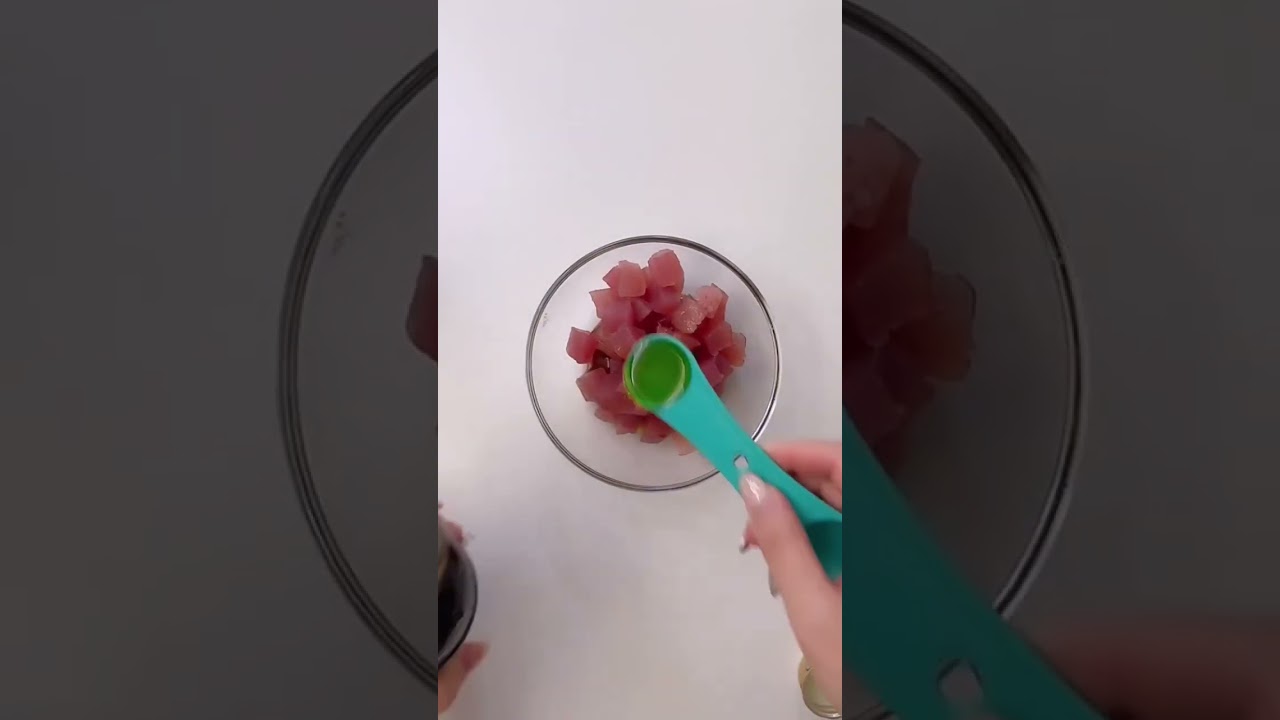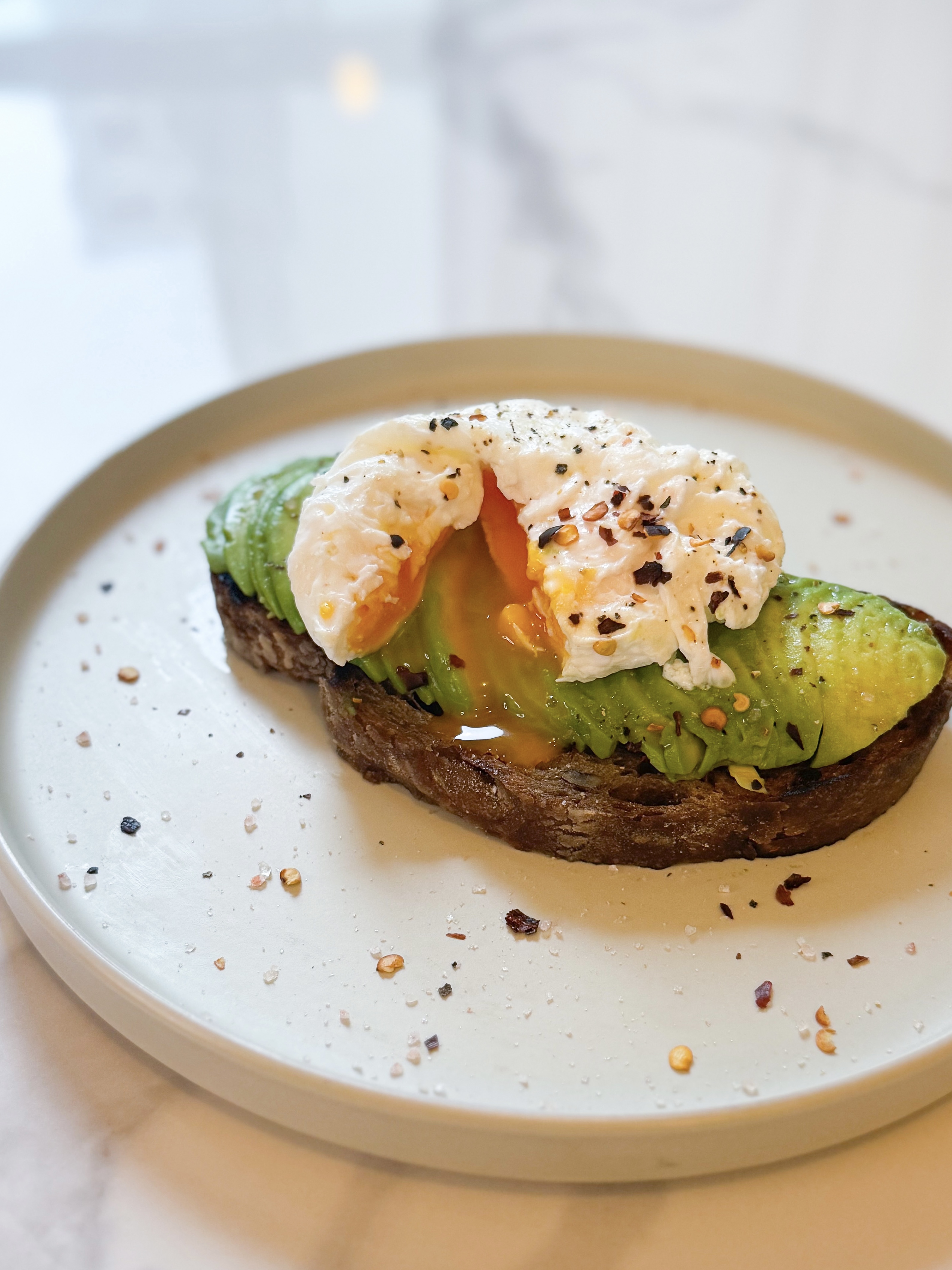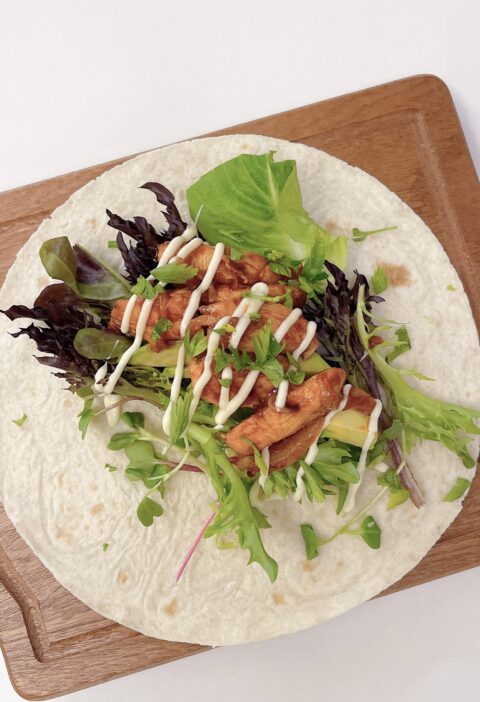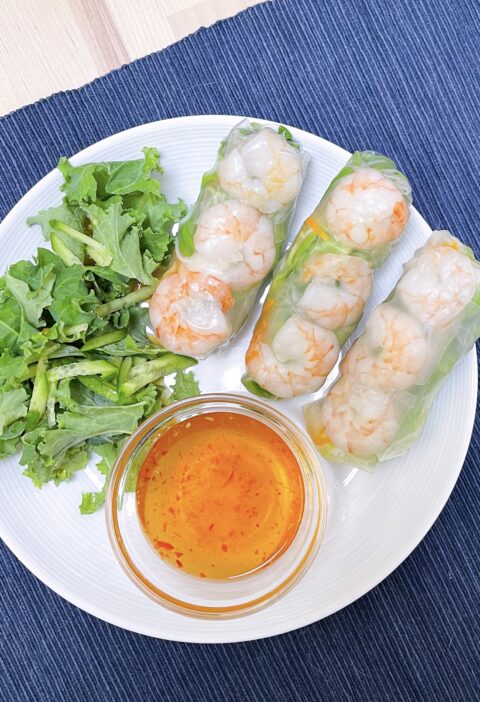What is Tuna Tartare?
Tuna tartare is a delectable seafood dish celebrated for its elegance and vibrant flavors. This culinary delight features sushi-grade tuna, often yellowfin or ahi tuna, which is finely diced or chopped into small, uniform pieces. The fresh, deep-red tuna is typically served raw, and its mild, clean flavor is a perfect canvas for a symphony of seasonings and condiments.
This dish boasts a harmonious blend of savory and umami notes, thanks to ingredients like soy sauce, sesame oil, fresh ginger, and garlic. To add a refreshing zing and a touch of acidity, it’s common to include citrus juice, typically from lime or lemon. This not only enhances the flavor but also slightly “cooks” the tuna through a process known as denaturation.
Tuna tartare often carries a subtle kick of heat, with the inclusion of ingredients like red pepper flakes or hot sauce, though the level of spiciness can be customized to personal preferences. To introduce contrasting textures, some variations of the dish incorporate diced avocado, cucumber, or tobiko (flying fish roe).
The presentation of tuna tartare is an art form in itself. The seasoned tuna is carefully shaped into a neat mound using a ring mold, and it’s commonly garnished with items like microgreens, radish slices, or an additional drizzle of sauce. The dish is typically accompanied by crispy wonton chips or a side of fresh greens, enhancing both taste and visual appeal.
Tuna tartare is not only a culinary sensation but also a visual masterpiece, with its vivid colors and fresh presentation. Its unique combination of flavors and textures makes it a delightful appetizer or entrée that’s enjoyed in seafood restaurants and fine dining establishments around the world.
Tuna tartare is not only delicious but is also visually appealing, with its vibrant colors and fresh presentation. Because it’s made with raw fish, it’s important to use the freshest ingredients and maintain proper food safety to reduce the risk of foodborne illness.
Can You Eat Raw Tuna?
Yes, you can eat tuna raw, but it’s essential to use high-quality, sushi-grade tuna specifically prepared for raw consumption. Tuna served raw in dishes like sushi, sashimi, or tuna tartare must meet strict safety and quality standards to reduce the risk of foodborne illness.
Sushi-grade tuna, often referred to as “sashimi-grade” or “superfrozen” tuna, is flash-frozen at very low temperatures to kill any potential parasites and ensure its safety for raw consumption. This freezing process maintains the quality and texture of the fish while reducing health risks.
If you plan to prepare or consume raw tuna at home, it’s crucial to purchase it from a reputable source that understands the requirements for sushi-grade fish. Additionally, proper handling, storage, and sanitation practices are essential to maintain food safety.
Consuming raw tuna can be a delightful culinary experience, but it’s important to prioritize food safety and quality when doing so.
How Many Calories are there in Tuna Tartare? Is Tuna Tartare Healthy?
A standard serving of tuna tartare, which is approximately 3.5 to 4 ounces (about 100-115 grams), typically contains around 150 to 200 calories. Keep in mind that the caloric content can vary depending on factors like the type and amount of additional ingredients, such as avocado, sauce, or crispy wonton chips.
Whether tuna tartare is considered healthy depends on several factors:
- Nutritional Value: Tuna is an excellent source of high-quality protein, omega-3 fatty acids, and various essential nutrients. It’s low in saturated fat and a healthy addition to your diet.
- Additional Ingredients: The overall healthiness of tuna tartare can be influenced by the ingredients used. For instance, adding avocado contributes healthy fats, while excessive amounts of sauce or high-calorie accompaniments may increase the caloric content.
- Serving Size: As with any dish, portion size is important. Eating tuna tartare in moderation is generally a healthy choice.
- Preparation: How the dish is prepared matters. For example, using minimal amounts of salt and sugar in the seasoning can make it a healthier option.
- Individual Dietary Needs: What is considered healthy varies from person to person, depending on their dietary goals and nutritional requirements.
In general, tuna tartare can be a nutritious and healthy dish when prepared thoughtfully with fresh, high-quality ingredients. It’s a good source of lean protein and healthy fats.
What are the Ingredients to Make Tuna Tartare?
To make a basic tuna tartare, you’ll need the following ingredients:
- Sushi-Grade Tuna: Approximately 8-10 ounces (225-280 grams) of high-quality, sushi-grade tuna. Yellowfin or ahi tuna is commonly used. Ensure that it’s very fresh and free of any bones or skin.
- Soy Sauce: About 1-2 tablespoons of low-sodium soy sauce for seasoning. Adjust the quantity to your taste.
- Sesame Oil: 1-2 teaspoons of toasted sesame oil for flavor.
- Fresh Ginger: 1-2 teaspoons of freshly grated or minced ginger for a zesty kick.
- Garlic: 1 small clove of garlic, minced (optional), for added flavor.
- Lime or Lemon Juice: The juice of one lime or half a lemon, or to taste, for a touch of acidity.
- Salt and Pepper: A pinch of salt and a dash of black pepper to season.
- Optional Ingredients: These can be added for additional flavor and texture:
- Diced avocado
- Diced cucumber
- Chopped scallions or chives
- Tobiko (flying fish roe)
- Red pepper flakes or hot sauce for spiciness
- Garnishes: Microgreens, sliced radishes, or extra sauce for garnishing.
- Serving Accompaniments: Crispy wonton chips, crackers, or fresh greens for serving.
These are the basic ingredients for a simple tuna tartare. You can adjust the seasonings and optional ingredients to suit your taste preferences. Keep in mind that using the freshest, highest-quality tuna is crucial when preparing raw dishes like tuna tartare to ensure both safety and taste.
Can I Substitute Tuna with Other Ingredients?
Yes, you can absolutely substitute tuna with other ingredients to create variations of tartare dishes. Tuna tartare is a versatile concept, and you can adapt it to your taste or dietary preferences. Here are a few alternative ingredients you can use as the primary component for tartare:
- Salmon: Salmon tartare is a popular alternative to tuna tartare. You can use fresh, sushi-grade salmon and prepare it in a similar way, typically using ingredients like soy sauce, sesame oil, and citrus for seasoning.
- Yellowtail (Hamachi): Yellowtail, another sushi-grade fish, is often used to create a yellowtail tartare. It has a distinct flavor that pairs well with ingredients like yuzu, avocado, and jalapeño.
- Scallops: Scallop tartare is a delicate and elegant option. You’ll need fresh sea scallops, which are diced and seasoned with ingredients like lemon juice, olive oil, chives, and perhaps a touch of truffle oil.
- Vegetarian Options: For a vegetarian or vegan tartare, consider using ingredients like diced or marinated tofu, mushrooms, or even beets. These alternatives can be seasoned and seasoned in a similar way to traditional tartare.
- Avocado: Avocado tartare is a creamy and delicious alternative. You can combine diced avocado with ingredients like lime juice, cilantro, and red onion for a fresh, guacamole-like tartare.
- Fruit-Based Tartare: Experiment with fruit-based tartare using ingredients like diced mango, watermelon, or papaya. These variations can be seasoned with citrus juice, fresh herbs, and a touch of honey.
Remember that the key to a successful tartare, regardless of the main ingredient, is using the freshest, high-quality components and balancing the seasonings to create a harmonious and flavorful dish. Feel free to get creative and explore different combinations to suit your taste and dietary preferences.
How to Make Tuna Tartare?
Making tuna tartare is relatively simple, and it’s a great way to enjoy the fresh, clean flavors of high-quality tuna. Here are step-by-step instructions for preparing a basic tuna tartare:
Instructions:
- Prepare the Tuna:
- Start by ensuring your tuna is sushi-grade and very fresh. It should be firm and free of any bones or skin. Using a sharp knife, cut the tuna into small, uniform cubes. The size of the cubes can vary depending on your preference, but they’re typically about 1/4 to 1/2 inch in size. Place the diced tuna in a clean bowl.
- Season the Tuna:
- In the bowl with the diced tuna, add 1-2 tablespoons of low-sodium soy sauce for seasoning. The soy sauce will add a savory umami flavor to the dish. Additionally, add 1-2 teaspoons of toasted sesame oil to impart a nutty and aromatic essence to the tuna. Freshly grated or minced ginger (1-2 teaspoons) contributes a zesty and fragrant element. If you enjoy the taste of garlic, you can include 1 small clove of minced garlic (optional).
- Add Citrus Juice:
- Squeeze the juice of one lime or half a lemon over the seasoned tuna. The citrus juice provides a refreshing zing and helps “cook” the tuna slightly through a process called denaturation. Start with a moderate amount of juice and adjust to your taste preferences.
- Season with Salt and Pepper:
- Add a pinch of salt and a dash of black pepper to the tuna mixture. These seasonings should be added in moderation, as the soy sauce already contains salt. Taste the mixture and make any necessary adjustments to the seasonings.
- Optional Ingredients:
- If you’re including optional ingredients like diced avocado, cucumber, chopped scallions, tobiko (flying fish roe), or red pepper flakes for spiciness, gently fold them into the tuna mixture. These optional ingredients can provide additional flavors and textures to your tartare.
- Chill the Tartare:
- Cover the bowl with plastic wrap or a lid and refrigerate the tuna tartare for about 15-20 minutes. Chilling allows the flavors to meld, and the dish becomes refreshing and slightly firmer.
- Serve and Garnish:
- When you’re ready to serve, use a ring mold or a spoon to shape the tuna tartare into a neat mound on individual serving plates. Garnish the top with microgreens, sliced radishes, or an extra drizzle of sauce. Tuna tartare is often served with crispy wonton chips, crackers, or a side of fresh greens.
- Enjoy: Serve your tuna tartare immediately, and enjoy the delicious, fresh flavors of this elegant dish.
Please note that it’s essential to use high-quality, sushi-grade tuna and adhere to proper food safety practices when preparing and serving raw dishes like tuna tartare.
How to Make Healthy Tuna Tartare?
Here are some general points to help you make healthier ingredient choices when preparing tuna tartare:
- Soy Sauce Alternatives: Use reduced-sodium soy sauce or low-sodium alternatives to reduce the dish’s sodium content.
- Healthy Fats: Consider adding ingredients like diced avocado, which provides healthy fats and a creamy texture.
- Fresh Produce: Incorporate fresh elements like diced cucumber, which adds freshness and crunch to the dish.
- Citrus Zest: Utilize the zest of citrus fruits (lime or lemon) for a burst of flavor without the added acidity of the juice.
- Herbs and Greens: Add fresh herbs like cilantro or microgreens for extra nutrients and vibrant flavors.
- Spice It Up: Use herbs and spices like fresh mint, cilantro, or red pepper flakes for added flavor and a hint of heat.
- Whole Grains: Serve your tuna tartare with whole-grain crackers or crispbreads for additional fiber, which contributes to a more balanced meal.
- Portion Control: Be mindful of portion sizes to keep the dish in moderation and maintain a healthier balance.
By incorporating these healthier ingredient alternatives and portion control, you can create a tuna tartare that’s not only delicious but also more nutritious and mindful of dietary preferences.
What is the Best Way to Serve Tuna Tartare?
Tuna tartare is a visually appealing and delicious dish, and the presentation plays a significant role in enhancing the overall dining experience. Here’s the best way to serve tuna tartare to make it look and taste fantastic:
Plate Presentation:
- Use a Ring Mold: If you have a ring mold or a round cookie cutter, it’s an excellent tool for creating an elegant presentation. Place the ring mold on the center of the serving plate.
- Shape the Tartare: Carefully spoon the prepared tuna tartare mixture into the ring mold, pressing it down gently to pack it. This will give your tartare a neat, round shape.
- Garnish: Garnish the top of the tuna tartare with visually appealing elements like microgreens, thinly sliced radishes, or additional sauce drizzled artfully over the top.
- Crackers or Chips: To serve, consider placing crispy wonton chips, crackers, or toast points around the tartare. These can be used as dippers, providing both a delightful texture and a practical means to enjoy the dish.
Additional Tips:
- Freshness: Serve the tuna tartare as soon as it’s prepared to maintain its freshness and vibrant flavors.
- Chilled Plates: It’s a good idea to chill the serving plates or use chilled dishes to help keep the tartare cold and refreshing.
- Dress Simply: While an elegant presentation can elevate the dish, it’s also important not to overcomplicate it. The beauty of tuna tartare lies in its simplicity and the spotlight it shines on the quality of the ingredients.
- Customization: Offer optional additions or sides for diners to customize their tartare. For example, you can provide additional soy sauce or hot sauce on the side for those who prefer a bit more seasoning.
- Accompaniments: Consider serving the tuna tartare with a light side salad or a selection of pickled vegetables to balance the flavors.
By presenting your tuna tartare thoughtfully and with attention to detail, you’ll create an inviting and enticing dish that not only looks great but also tastes fantastic.
How to and How Long Can I Store Tuna Tartare?
Tuna tartare is best enjoyed shortly after it’s prepared to ensure both its freshness and safety. Unlike cooked dishes, raw seafood, even when sushi-grade, is more perishable and can be susceptible to bacterial growth if not handled and stored correctly.
Storing leftover tuna tartare can be challenging because it’s a raw dish and is more perishable than cooked food. While it’s best to enjoy tuna tartare immediately after preparation for the freshest and safest experience, if you have leftover tuna tartare and want to store it, here’s what you can do:
Refrigeration (Short-Term Storage):
- If you have a small amount of leftover tuna tartare, place it in an airtight container.
- Seal the container tightly to minimize air exposure.
- Store it in the refrigerator at or below 40°F (4°C).
Tuna tartare can be safely stored in the refrigerator for a short period, usually up to 24 hours, but its texture and freshness will deteriorate over time.
Freezing (Not Recommended):
Freezing is generally not recommended for tuna tartare because freezing can alter the texture and quality of raw fish. The dish is at its best when enjoyed fresh, so freezing can diminish the overall experience.
If you do decide to freeze it, follow the same steps as mentioned for refrigeration, but keep in mind that the texture and taste may be compromised after thawing.
Always use sushi-grade tuna from a reputable source when preparing tuna tartare, practice good food safety, and follow proper handling and storage guidelines to minimize the risk of foodborne illness. If you have any concerns about the freshness or safety of leftover tuna tartare, it’s better to be cautious and consume it within a shorter timeframe.
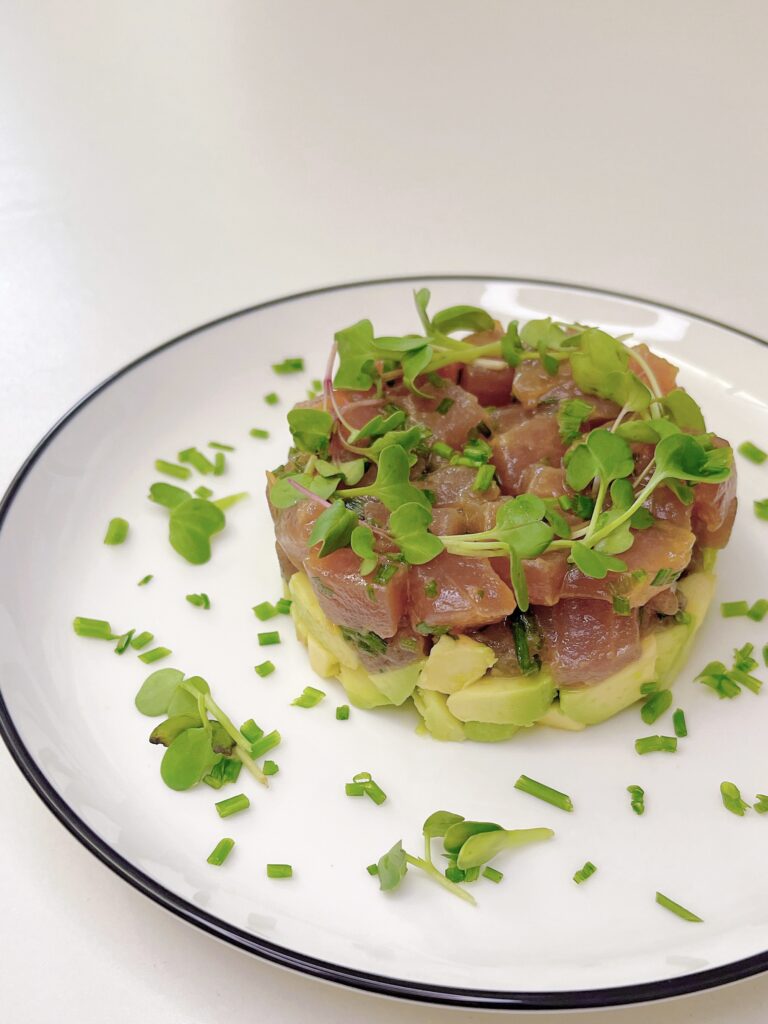
Healthy Tuna Tartare
Description
Making tuna tartare is relatively simple, and it’s a great way to enjoy the fresh, clean flavors of high-quality tuna. Here are step-by-step instructions for preparing a basic tuna tartare:
Ingredients
Instructions
- Prepare the Tuna:
Start by ensuring your tuna is sushi-grade and very fresh. It should be firm and free of any bones or skin. Cut it into small, uniform cubes. The size of the cubes can vary depending on your preference, but they’re typically about 1/4 to 1/2 inch in size. - Season the Tuna:
In a mixing bowl, combine the diced tuna with the soy sauce, sesame oil, freshly grated ginger, and minced garlic (if using). Stir gently to coat the tuna evenly. These ingredients will add flavor and a savory depth to the dish. - Add Citrus Juice:
Squeeze the juice of one lime or half a lemon over the seasoned tuna. The acidity from the citrus not only adds a refreshing zing but also slightly “cooks” the tuna through a process called denaturation. Adjust the amount of juice to your taste. - Season with Salt and Pepper:
Add a pinch of salt and a dash of black pepper to the tuna mixture. Taste and adjust the seasonings as needed. - Optional Ingredients:
If you’re adding any optional ingredients like diced avocado, cucumber, or scallions, gently fold them into the mixture at this stage. - Chill the Tartare:
Cover the bowl and refrigerate the tuna tartare for about 15-20 minutes. Chilling allows the flavors to meld and the dish to become refreshing and slightly firm. - Serve and Garnish:
When you’re ready to serve, shape the tuna tartare into a neat mound using a ring mold if desired, or simply use a spoon. Garnish with microgreens, sliced radishes, or an extra drizzle of sauce. Tuna tartare is often served with crispy wonton chips, crackers, or a side of fresh greens. - Enjoy:
Serve your tuna tartare immediately and enjoy the delicious, fresh flavors.
Remember to use high-quality, sushi-grade tuna and follow proper food safety practices when preparing raw dishes like tuna tartare.
Notes
- Tuna tartare is a versatile and visually appealing dish. It can be served as an appetizer, a light meal, or as a side. The key to a great tuna tartare is using fresh, high-quality tuna and balancing the flavors to your taste. Enjoy your homemade tuna tartare!



